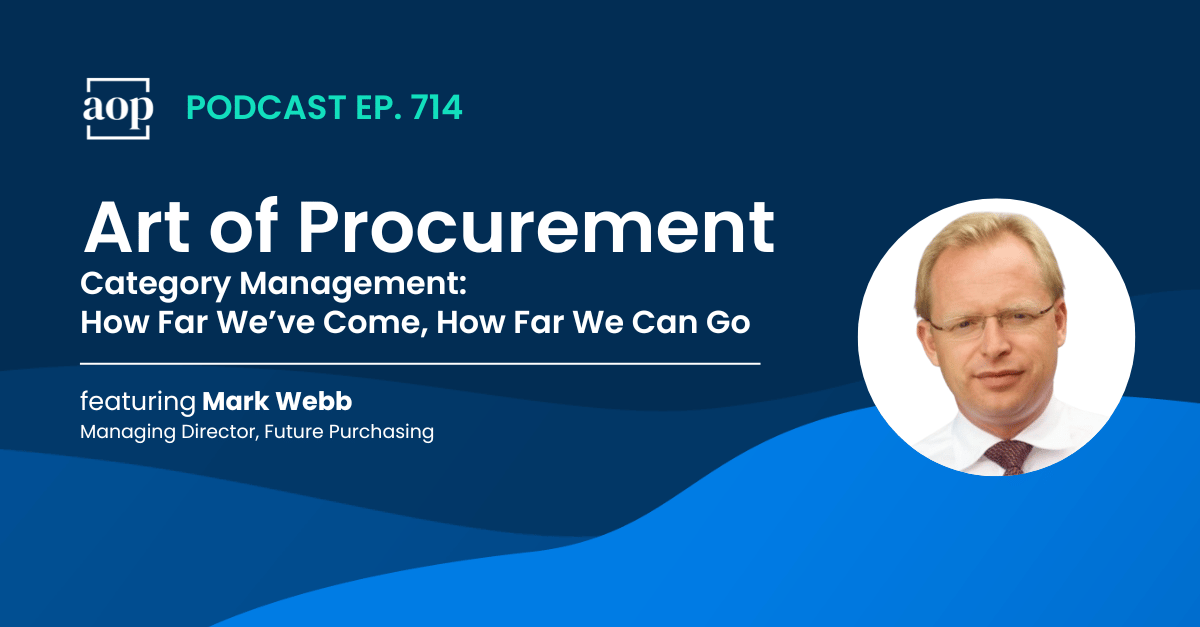
“I think category management is great fun because you have the freedom to do things. It’s not following a rote process. It’s using structure to be creative. I think that’s the great benefit of it.” – Mark Webb, Managing Director at Future Purchasing
There’s a widespread assumption among many in procurement that category management, which has been established as a discipline in its own right for over 40 years, is a widely adopted, well understood strategic aspect of procurement that is now just ‘old hat.’
While true for some teams, that misconception ignores the more underdeveloped aspects of category management’s maturity level, missing potential value-creating opportunities for procurement to improve upon some of the gaps, miscommunications, and key performance indicators.
Recently, I welcomed Mark Webb, Managing Director at Future Purchasing, back to the podcast to discuss some of the current challenges and opportunities within category management, using their newly published 2024 Global Category Management Report as a basis for the conversation.
Mark shared some of the more notable insights from the report, including the fact that a whopping 86 percent of stakeholders don’t understand their role in category management, as well as best practices for how category managers can adapt and mature their operating models to deliver more value – and improve communication about that value across the business.
I wanted to capture some of Mark’s most valuable takeaways from our conversation. Here is Mark, in his own words, on the current and future states of category management:
What category management is, and isn’t
“For us, it is that connection between the supply market and the internal requirements and the strategic objectives of the organization, and finding a way to transform the value that you get from the procurement spend.
It’s a much more collaborative approach. It’s one where the technical side from the business and the commercial procurement team are working hand-in-hand. That’s different from strategic sourcing which tends to be a bit more output-orientated around running a sourcing event.”
Who is getting category management right?
“When we do the global category management reports, we always find about five to seven percent of people are really excellent. They are the leaders out there. But, there is a big chunk of respondents that are just getting started.
Then, there is a 20 percent group in-between who are the ‘improvers.’ There are big organizations in that ‘improver’ space as well. We have a lot more to do for these ‘starter’ and ‘improver’ groups, and I think digital will give it a bit of a boost now that digital category management is making more inroads.”
Trends in the digitization of category management
“The technology isn’t where it could be and where it will be, and the use of AI is somewhat overplayed because some of it is more to me like formalizing a decision and more decision-based. But AI will become more prevalent with some of the data that is available.
Of course, that means refreshing your strategy with real experience, and that is really hard to do because security and independent perspectives of that data belong to a particular organization.”
Avoid the ‘silo’ trap in category management
“There’s a temptation with some of these tools to use them in a silo, and there is almost a parallel track where all of the creativity that you get from working with business stakeholders shouldn’t be lost at the same time.
Category managers need to use their tools in parallel with engaging people in the same way that we would have done through workshops and getting those engineers, marketing people, or scientists on the business side to give you their ideas. Then it becomes a joint strategy that everybody buys into. By doing this, it gets implemented much faster.”
What defines a good category management strategy?
“Go through strategies and come up with a checklist using some lean principles about definitions, like what does good look like? Make it very specific for each of the key tools that we would see within the strategy. That is something that people can do. It doesn’t take particularly long. …
The really big thing for us is having callouts in every area where we say, ‘What are the conclusions? What are the insights that you’ve developed from doing this piece of analysis?’ People are quite good at filling out templates, but it’s the insights and the takeaways where you want to spend the most attention.”
Making meaning out of category insights
“Don’t be afraid to roll up your sleeves and get into the dirt. You can’t get it really to every level of detail you want – initially maybe, if you are in a big global organization. Ask yourself how you are spending that money. What is the cost model that you put from one location to another? You are starting to see insights.
When you see category managers thinking like that and they know what the levers are and they are really digging into it, that is a great strategy because that is not particularly strategic all the time, but it is knowing that you are hovering that up and down all the time, going very high level, but also not being afraid to drop down and start to do some detailed analysis.”
Subscribe to Art of Procurement
Apple | Stitcher | iHeart Radio | Email




